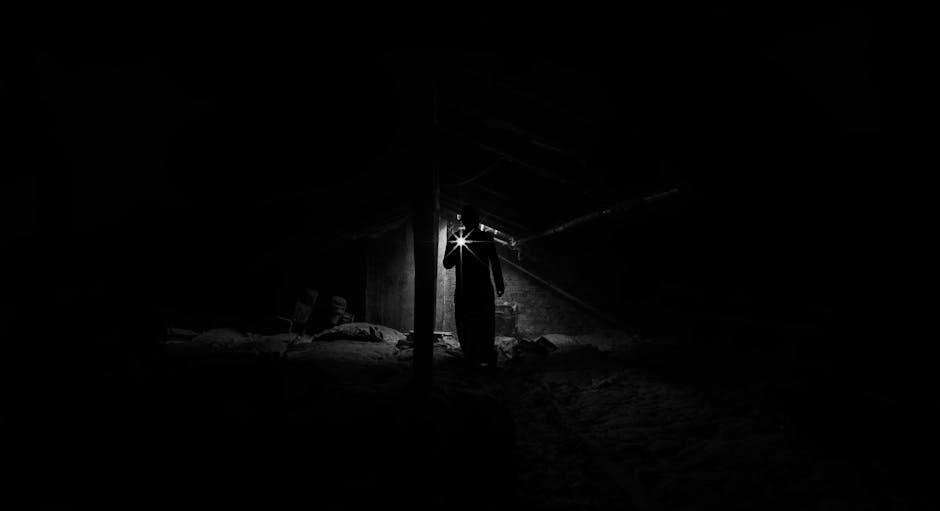Mark Twain’s A Ghost Story is a satirical tale that mocks superstition, showcasing Twain’s mastery of wit and humor. Available as a free PDF, it remains a delightful read, blending supernatural themes with sharp social commentary, proving its enduring relevance in American literature.
1.1 Background and Publication History
Mark Twain’s A Ghost Story was first published in 1880 and later included in the collection Sketches New and Old in 1903. The story, also known as A Ghosts Tale, was derived from the Internet Wiretap Edition and is now in the public domain, having been placed there in May 1993. It is distributed under the GNU Public License, making it widely accessible. The narrative was originally part of Samuel Clemens’ (Mark Twain’s) works, with the PDF version being a popular format among literature enthusiasts. This story remains a significant piece in Twain’s oeuvre, blending humor and supernatural themes while critiquing societal norms of his time.
1.2 Significance in Mark Twain’s Works
A Ghost Story stands out as a unique blend of satire and supernatural themes in Mark Twain’s works. It showcases his ability to use humor and irony to critique societal superstitions and norms. The story’s availability in PDF format has made it easily accessible to modern readers, ensuring its continued relevance. Twain’s exploration of the ghost story genre not only mocks traditional narratives but also reflects his broader skepticism of societal beliefs. This piece, alongside his other works like The Adventures of Huckleberry Finn, highlights Twain’s versatility as a writer and his enduring influence on American literature. Its satirical edge remains a hallmark of his literary style, resonating with readers today.

Historical Context of the Story

The story, written in 1885, reflects late 19th-century American cultural and social shifts. Twain’s exploration of the supernatural aligns with the era’s fascination with spirituality and rationality.

2.1 The Ghost Story Genre in the 19th Century
The ghost story genre in the 19th century was immensely popular, with authors like Charles Dickens and Edgar Allan Poe leading the way. Their works often blended folklore with psychological depth, fascinating readers and reflecting societal anxieties. The era’s rapid industrialization and urbanization contributed to the genre’s appeal, offering audiences a way to engage with the unknown amidst unsettling changes. Serialized publication in magazines made these stories widely accessible, increasing their influence. This period set the stage for Mark Twain’s “A Ghost Story,” which uniquely combined humor and social critique within a supernatural narrative, standing out in the genre.
2.2 Mark Twain’s Approach to Supernatural Themes
Mark Twain’s approach to supernatural themes in “A Ghost Story” is characterized by his signature blend of humor, satire, and skepticism. Unlike traditional 19th-century ghost stories, Twain avoids horror, instead using irony and wit to explore the supernatural. His narrative often mocks superstition, presenting ghostly encounters as absurd or mundane. Twain’s characters frequently rationalize paranormal events, reflecting his own rationalist worldview. This unique approach allows him to critique societal beliefs while entertaining readers. Twain’s work stands out for its lighthearted take on the genre, using the supernatural as a vehicle for social commentary rather than fear. His style influences the story’s tone, making it both humorous and thought-provoking.

Key Themes in A Ghost Story
Satire, superstition, and humor are central to Mark Twain’s “A Ghost Story.” The narrative critiques societal norms, explores rationality versus belief, and uses wit to engage readers.
3.1 Satire and Social Commentary
In A Ghost Story, Mark Twain employs satire to critique societal norms and superstitions prevalent during his time. The narrative humorously challenges the notion of ghostly encounters, using irony to expose human gullibility and the tendency to seek meaning in irrational events. Twain also subtly comments on the commercialization of spirituality, reflecting his skepticism toward organized religion and societal hypocrisy. Through the ghost’s absurd demands and the narrator’s pragmatic responses, Twain highlights the clash between superstition and rationality. This satirical approach not only entertains but also invites readers to reflect on the follies of human belief systems, showcasing Twain’s mastery of blending humor with sharp social critique.
3.2 Superstition and Rationality
Mark Twain’s A Ghost Story delves into the conflict between superstition and rationality, using the ghostly encounter to examine societal beliefs. The ghost, representing superstition, imposes irrational demands, while the narrator’s pragmatic responses embody rationality. Twain uses humor to expose the absurdity of unquestioned beliefs, prompting readers to challenge supernatural explanations. The story reflects Twain’s skepticism toward superstition, advocating for logical reasoning. This dynamic interplay entertains while commenting on human irrationality, reinforcing Twain’s role as a keen social critic.
3.3 Humor in the Narrative
Humor plays a pivotal role in A Ghost Story, as Mark Twain masterfully employs wit and irony to engage readers. The narrator’s deadpan reactions to supernatural events create comedic tension, while the ghost’s absurd demands add layers of absurdity. Twain’s signature humor critiques societal norms, using laughter to highlight human folly. The story’s lighthearted tone contrasts sharply with its darker themes, making it both entertaining and thought-provoking. This blend of humor and satire underscores Twain’s ability to weave complex ideas into an accessible narrative, ensuring the story remains memorable and impactful.

Availability of A Ghost Story in PDF Format
Mark Twain’s A Ghost Story is widely available in PDF format due to its public domain status. Fans can easily access and download it for free online.
4.1 Sources for Downloading the PDF
Mark Twain’s A Ghost Story is available in PDF format from various online sources. Project Gutenberg offers a free, downloadable version, as does ManyBooks. Google Books and archive.org also provide access, often with additional formatting options. Some university libraries and educational websites host the story for public access. Always ensure the source is reputable to avoid copyright or security issues. These platforms make Twain’s work easily accessible for readers worldwide.
4.2 Copyright and Public Domain Status
A Ghost Story by Mark Twain is in the public domain, as Twain passed away in 1910, and U.S. copyright law grants protection for a limited time. Works published before 1927 are generally public domain, allowing free access and distribution. Readers can legally download and share the PDF without copyright concerns. However, specific editions may include introductions or annotations under copyright. Always verify the source for any restrictions. The public domain status ensures that Twain’s work remains accessible to everyone, promoting its reading and study worldwide.
Literary Analysis of the Story
Mark Twain’s A Ghost Story masterfully blends humor with poignant social commentary, exploring themes of superstition and rationality through a haunting yet satirical narrative.
5.1 Plot Summary and Structure
A Ghost Story by Mark Twain revolves around a young man who encounters a ghost in a haunted house. The narrative begins with a traditional ghost story setup, only to subvert expectations. The ghost, rather than seeking revenge, is on a mission to reclaim buried treasure, leading to a series of comedic and satirical events. Twain’s structure is episodic, with each chapter revealing the ghost’s motivations and the protagonist’s reactions. The story shifts from horror to humor, blending genres to critique societal greed and superstition. Twain’s use of irony and wit transforms the tale into a commentary on human nature, making it a unique blend of horror and satire.
5.2 Character Development and Symbolism
In A Ghost Story, Mark Twain crafts a narrative where the protagonist, a young man, evolves from skepticism to curiosity, engaging with the supernatural. The ghost, a former slave owner, symbolizes guilt and unfinished business, trapped by his past. Twain uses the treasure as a metaphor for greed and materialism, while the house represents entrapment. The characters’ interactions highlight the clash between rationality and superstition, a recurring theme in Twain’s work. The ghost’s desperation mirrors societal flaws, adding depth to the story. Twain’s symbolism enriches the plot, offering a critique of human nature and societal issues, while maintaining a humorous tone.

Reception and Legacy of A Ghost Story
The story received mixed reviews upon publication, with critics noting its uneven tone. Over time, it has been celebrated as a unique blend of humor and the supernatural, becoming a notable part of Twain’s legacy.
6.1 Contemporary Reviews and Criticism
Upon its release, A Ghost Story garnered mixed reviews, with many critics finding its blend of humor and supernatural elements unconventional. Some praised Twain’s ability to craft a tale that balanced wit and eerie atmosphere, while others felt the narrative lacked focus. The story’s departure from Twain’s typical realism puzzled some readers, leading to divided opinions. Despite this, the tale was celebrated for its originality and Twain’s signature irony. Critics noted how the story subtly critiqued societal superstitions, aligning with Twain’s broader satirical themes. Over time, it has been recognized as a unique addition to Twain’s body of work, showcasing his versatility as a writer.
6.2 Modern Interpretations and Adaptations
Modern scholars and readers continue to explore A Ghost Story for its unique blend of humor, satire, and supernatural themes. Many interpret the tale as a reflection of Twain’s skepticism toward societal norms and superstitions. Academic discussions often highlight its experimental nature, blending genres in a way that challenges traditional storytelling. Adaptations have also emerged, including radio dramas and stage plays, which reimagine the story for contemporary audiences. These interpretations emphasize Twain’s timeless wit and his ability to weave moral commentary into entertaining narratives. The story’s enduring appeal lies in its ability to provoke thought while maintaining a lighthearted tone, ensuring its relevance in modern literary discourse.

Mark Twain’s Other Works and Their Relation to A Ghost Story
Mark Twain’s A Ghost Story reflects his mastery of blending humor with social critique, akin to his famous works like The Adventures of Huckleberry Finn and The Adventures of Tom Sawyer. While these novels are more renowned, A Ghost Story showcases Twain’s versatility in exploring supernatural themes, a departure from his typical realism. The story’s satirical undertones and moral reflections align with his broader literary style, emphasizing human folly and societal hypocrisy. This tale, though less celebrated, enriches Twain’s oeuvre by demonstrating his ability to experiment with genre while maintaining his signature wit and depth.
7.1 Comparison with The Adventures of Huckleberry Finn
While A Ghost Story differs significantly from The Adventures of Huckleberry Finn in genre and tone, both works showcase Mark Twain’s mastery of satire and social commentary. Huckleberry Finn is a seminal novel exploring race, morality, and identity in pre-Civil War America, whereas A Ghost Story delves into supernatural themes with a humorous edge. Despite these differences, both works reflect Twain’s ability to critique societal norms, albeit through contrasting narrative styles. The former is a deeply introspective journey, while the latter uses irony and wit to highlight human gullibility. Both, however, reinforce Twain’s enduring legacy as a chronicler of the American experience, blending entertainment with profound insight into human nature.
7.2 Similar Themes in Other Twain Stories
Mark Twain’s A Ghost Story shares thematic similarities with his other works, such as The Man That Corrupted Hadleyburg and The $30,000 Bequest. These stories often explore human nature, superstition, and the absurdity of societal norms. Twain’s signature humor and satire are present in all, as he critiques greed, hypocrisy, and irrational belief systems. For instance, the interplay of superstition and rationality in A Ghost Story mirrors the gullibility of characters in The Man That Corrupted Hadleyburg. Similarly, the use of irony and wit to expose human flaws is a common thread. These recurring themes highlight Twain’s consistent focus on societal critique, cementing his reputation as a master of satirical storytelling.
The Role of A Ghost Story in Twain’s Satirical Oeuvre
Mark Twain’s A Ghost Story exemplifies his satirical prowess, using humor and irony to critique societal norms and superstitions, aligning with his broader critique of American culture.
8.1 Use of Irony and Wit
Mark Twain’s A Ghost Story masterfully employs irony and wit to subvert traditional ghost tale expectations, reflecting his signature satirical style. The narrative humorously portrays a ghost obsessed with trivial matters, such as a missing boot, rather than eerie hauntings. Twain uses this irony to critique societal superstitions and the overblown nature of supernatural tales. His witty dialogue and absurd scenarios challenge readers to question the validity of ghostly encounters, blending humor with sharp social commentary. This approach not only entertains but also underscores Twain’s skepticism of unreasoned beliefs, aligning with his broader critique of American society and cultural norms. The story’s lighthearted yet incisive tone highlights Twain’s mastery of satirical storytelling.
8.2 Critique of American Society
Mark Twain’s A Ghost Story subtly critiques American society by using the supernatural as a metaphor for societal flaws. The narrative mocks the greed and materialism prevalent during the Gilded Age, as characters prioritize wealth over ethical concerns. Twain’s portrayal of a ghost fixated on trivial earthly matters reflects his disdain for the obsession with possessions. Additionally, the story highlights the gullibility of people swayed by superstition, mirroring Twain’s broader skepticism of blind tradition and religious dogma. His critique extends to the class system, as the ghost’s interactions reveal the social hierarchies of the time. Twain’s use of humor and irony underscores his sharp commentary on America’s moral and cultural shortcomings, aligning with his reputation as a satirist of societal norms.

The Story’s Place in American Literature
Mark Twain’s A Ghost Story holds a unique place in American literature, blending humor, satire, and supernatural elements to critique societal norms and cultural values effectively.
9.1 Influence on Later Authors
Mark Twain’s A Ghost Story has left a lasting impact on American literature, inspiring later authors to experiment with blending humor, satire, and supernatural themes. Its unique narrative style, which combines wit and social commentary, influenced writers like Kurt Vonnegut and George Saunders, who also explored genre-blurring storytelling. The story’s ability to critique societal norms through irony and humor has made it a benchmark for authors seeking to merge entertainment with intellectual depth. Twain’s approach to the supernatural as a tool for satire has encouraged later writers to use speculative elements for social critique. This legacy underscores Twain’s enduring influence on American literary innovation and his role in shaping the voices of subsequent generations of writers.
9.2 Contribution to the Ghost Story Genre

Mark Twain’s A Ghost Story redefined the ghost story genre by infusing it with satire and humor, departing from the traditional horror-focused narratives of the 19th century. Twain’s unique approach used supernatural elements to critique societal norms, offering a fresh perspective that encouraged readers to reflect on cultural and political issues. By blending folklore with rational explanations, the story challenged the genre’s conventions, making it more accessible and thought-provoking. This innovative style influenced the evolution of the ghost story, encouraging authors to experiment with genre boundaries and incorporate social commentary. Twain’s contribution remains significant, as it expanded the genre’s potential to address broader themes beyond mere fright.
Mark Twain’s A Ghost Story masterfully blends humor with social commentary, showcasing Twain’s storytelling genius. Its availability as a free PDF ensures accessibility while respecting copyright laws.
10.1 Final Thoughts on A Ghost Story
10.1 Final Thoughts on A Ghost Story
Mark Twain’s A Ghost Story is a captivating tale that blends humor with social commentary, reflecting Twain’s unique storytelling style. Its exploration of themes like superstition and rationality offers timeless insights into human nature. The story’s ability to entertain while provoking thought underscores Twain’s mastery of satire. As a PDF, it remains accessible to modern readers, ensuring its legacy endures. This work, though lesser-known than Twain’s major novels, contributes significantly to his satirical oeuvre, showcasing his wit and critique of societal norms. It stands as a testament to Twain’s enduring influence on American literature, continuing to engage readers with its blend of humor and profundity.
10.2 Mark Twain’s Enduring Legacy
Mark Twain’s enduring legacy is cemented as one of America’s most iconic writers, whose works continue to resonate with readers worldwide. His ability to weave humor, satire, and social commentary into compelling narratives has left an indelible mark on literature. A Ghost Story, though lesser-known than works like The Adventures of Huckleberry Finn, contributes to his legacy by showcasing his versatility and wit. Twain’s exploration of human nature, societal flaws, and moral dilemmas remains timeless, making his writing relevant across generations. The availability of his works, including A Ghost Story in PDF format, ensures that his ideas and insights are accessible to modern audiences, further solidifying his place in the pantheon of American literature.
